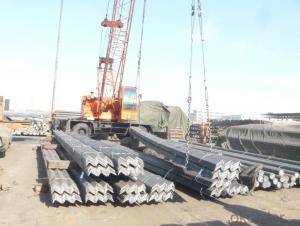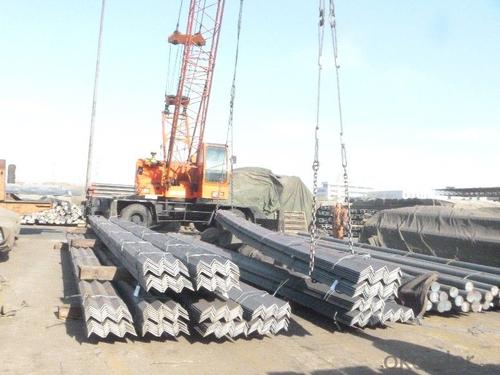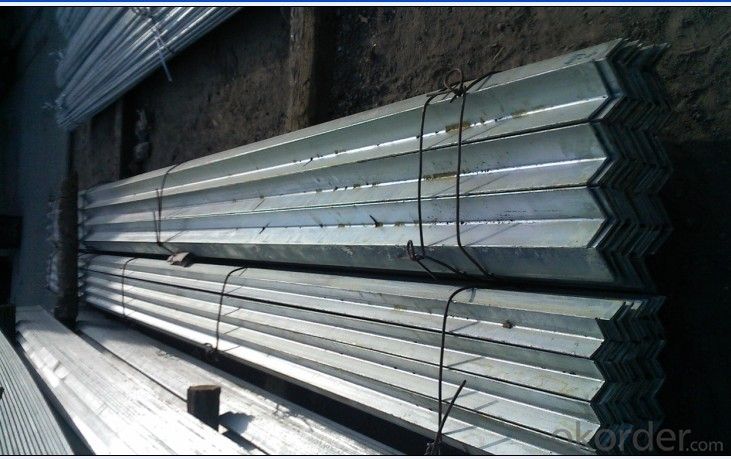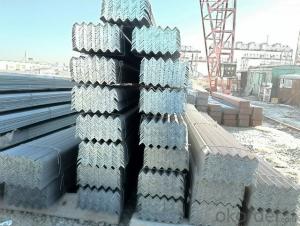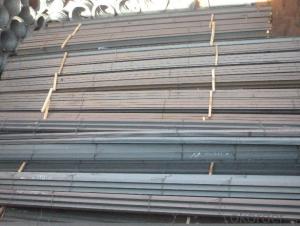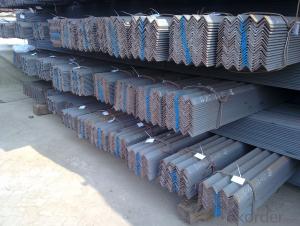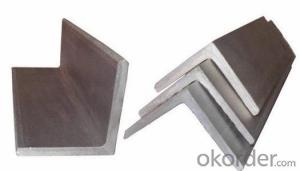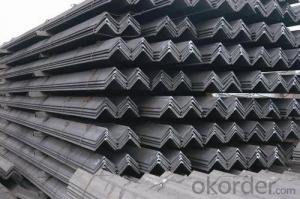angle bar
- Loading Port:
- China Main Port
- Payment Terms:
- TT OR LC
- Min Order Qty:
- -
- Supply Capability:
- -
OKorder Service Pledge
OKorder Financial Service
You Might Also Like
Product Description:
Specifications of Angle Steel
1. Invoicing on theoretical weight or actual weight as customer request
2. Length: 6m, 9m, 12m as following table
3. Sizes

Sizes: 25mm-250mm | ||
a*t | ||
25*2.5-4.0 | 70*6.0-9.0 | 130*9.0-15 |
30*2.5-6.6 | 75*6.0-9.0 | 140*10-14 |
36*3.0-5.0 | 80*5.0-10 | 150*10-20 |
38*2.3-6.0 | 90*7.0-10 | 160*10-16 |
40*3.0-5.0 | 100*6.0-12 | 175*12-15 |
45*4.0-6.0 | 110*8.0-10 | 180*12-18 |
50*4.0-6.0 | 120*6.0-15 | 200*14-25 |
60*4.0-8.0 | 125*8.0-14 | 250*25 |
5. Payment terms:
1).100% irrevocable L/C at sight.
2).30% T/T prepaid and the balance against the copy of B/L.
3).30% T/T prepaid and the balance against L/C
6.Material details:
Alloy No | Grade | Element (%) | | ||||
C | Mn | S | P | Si | | ||
| | |||||||
|
|
|
|
|
|
| |
Q235 | B | 0.12—0.20 | 0.3—0.7 | ≤0.045 | ≤0.045 | ≤0.3 | |
|
|
|
|
|
|
| |
Alloy No | Grade | Yielding strength point( Mpa) | | ||||
Thickness (mm) | | ||||||
≤16 | >16--40 | >40--60 | >60--100 | | |||
≥ | | ||||||
|
|
|
|
|
| | |
Q235 | B | 235 | 225 | 215 | 205 | | |
Alloy No | Grade | Tensile strength (Mpa) | Elongation after fracture (%) | | |||
Thickness (mm) | | ||||||
| ≤16 | >16--40 | >40--60 | >60--100 | | ||
≥ | | ||||||
|
|
|
|
|
|
| |
Q235 | B | 375--500 | 26 | 25 | 24 | 23 | |
Usage & Applications of Angle Steel
According to the needs of different structures, Angle can compose to different force support component, and also can be the connections between components. It is widely used in various building structures and engineering structures such as roof beams, bridges, transmission towers, hoisting machinery and transport machinery, ships, industrial furnaces, reaction tower, container frame and warehouse etc.
Packaging & Delivery of Angle Steel
1. Packing: it is nude packed in bundles by steel wire rod
2. Bundle weight: not more than 3.5MT for bulk vessel; less than 3 MT for container load
3. Marks:
Color marking: There will be color marking on both end of the bundle for the cargo delivered by bulk vessel. That makes it easily to distinguish at the destination port.
Tag mark: there will be tag mark tied up on the bundles. The information usually including supplier logo and name, product name, made in China, shipping marks and other information request by the customer.
If loading by container the marking is not needed, but we will prepare it as customer request.
Production flow of Angle Steel
Material prepare (billet) —heat up—rough rolling—precision rolling—cooling—packing—storage and transportation
- Q: Can steel angles be used for framing in residential construction?
- Certainly, steel angles have the potential to be utilized for framing purposes in residential construction. Due to their robustness and longevity, steel angles are commonly employed as vital components in construction projects. They can provide essential reinforcement and stability in various framing applications, such as wall framing, roof trusses, and floor joists. When it comes to residential construction, steel angles possess numerous advantages. They exhibit remarkable resistance against warping, shrinking, and rotting, rendering them an exceptionally dependable choice for framing purposes. Furthermore, steel angles have the added benefit of being fire-resistant, offering an additional layer of safety in residential structures. Ultimately, steel angles represent a versatile and cost-effective alternative for framing endeavors in residential construction projects.
- Q: What are the different methods of surface galvanizing for steel angles?
- Steel angles can be surface galvanized using various methods, each with its own benefits and uses. Here are some commonly employed techniques: 1. Hot-dip galvanizing: The most widely utilized method involves immersing steel angles in molten zinc, forming a strong bond with the surface. This process offers exceptional corrosion protection and durability, making it suitable for a wide range of applications. 2. Electro-galvanizing: This method involves electrodepositing a thin layer of zinc onto the steel angle's surface. It is a controlled process that provides a smoother and more even coating. Electro-galvanizing is often used for decorative purposes or when a thinner coating is sufficient. 3. Sherardizing: This method entails coating the steel angles with a mixture of zinc dust and proprietary filler materials, such as aluminum or iron powder. The coated angles are then heated in a furnace, causing zinc to diffuse into the steel's surface, forming a durable alloy layer. Sherardizing is ideal for applications requiring high resistance to wear and abrasion. 4. Mechanical galvanizing: Also known as centrifuge galvanizing, this method involves tumbling steel angles in a drum or barrel with zinc powder and glass beads. The tumbling action helps zinc powder adhere to the surface, creating a protective coating. Mechanical galvanizing is commonly used for small or intricate parts that are challenging to galvanize with other methods. 5. Zinc-rich paint: Although not a conventional galvanizing method, zinc-rich paint can offer similar corrosion protection. It involves applying a paint or coating with a high concentration of zinc particles to the steel angle's surface. These zinc particles act as sacrificial anodes, corroding instead of the steel and safeguarding against rust and corrosion. These methods represent just a few options for surface galvanizing steel angles. The choice of technique depends on factors such as desired corrosion protection, specific application requirements, and cost considerations. Consulting with a galvanizing professional is crucial to determine the most suitable method for your needs.
- Q: What are the different surface treatments available for galvanized steel angles?
- Some of the different surface treatments available for galvanized steel angles include powder coating, painting, and hot-dip galvanizing. Additionally, there are options for epoxy coating and zinc-rich primers to enhance corrosion resistance and provide a desired aesthetic finish.
- Q: What does "angle length" and "limb width" mean?
- The width of a limb refers to the width of the point to the edge of the angle, and the length of the limb corresponds to the length of the edge;Angle called angle, the steel strip is perpendicular to each other on both sides into the corner. There are equal angles and unequal angles. The two sides of an equal angle steel are equal in width. The specifications are expressed in millimeters of edge width * edge width * edge thickness. Such as "/ 30 x 30 x 3", that is 30 mm width equal angle, edge thickness of 3 mm.
- Q: How do you store steel angles?
- Steel angles can be stored in a variety of ways depending on the available space and the quantity of angles. Here are a few common methods: 1. Vertically: One option is to store steel angles vertically by leaning them against a wall or using a storage rack. This method is suitable for smaller quantities as it allows easy access to each angle. It is important to ensure that the angles are stable and securely positioned to prevent any accidents. 2. Horizontally: Another option is to store steel angles horizontally, especially if you have a larger quantity. This can be done by stacking them on a pallet or using a storage rack with compartments. When stacking, it is crucial to distribute the weight evenly and use spacers between the angles to avoid deformation. 3. Bundled: If you have a large number of steel angles, bundling them together can be a convenient storage method. This is achieved by tying the angles together with steel strapping or using banding equipment. Bundling helps to keep the angles organized and prevents them from shifting or falling during storage or transportation. Regardless of the storage method chosen, it is important to consider the following points: - Provide a clean and dry storage area to prevent rust or corrosion. - Ensure the storage area is well-ventilated to avoid moisture buildup. - Keep the angles away from direct sunlight and extreme temperature fluctuations. - Regularly inspect the angles for any signs of damage or corrosion. - Use appropriate lifting equipment and follow safety guidelines when moving or stacking steel angles.
- Q: What are the different methods of connecting steel angles together?
- When connecting steel angles together, there are various methods available depending on the specific application and structural needs. Some commonly used techniques include: 1. Welding: Utilizing a welding electrode, welding is an effective and frequently employed method. It involves melting the edges of the angles and joining them together, creating a permanent and robust connection. 2. Bolting: Another popular approach is bolting, which involves using bolts, nuts, and washers to secure the angles in place. This method allows for a strong connection that can also be easily disassembled if necessary. 3. Riveting: Riveting entails the use of metal pins known as rivets to connect steel angles. It requires drilling holes in the angles and inserting the rivets, which are then hammered or pressed to create a permanent connection. 4. Adhesive bonding: Adhesive bonding involves the use of industrial adhesives to connect steel angles. The adhesive is applied to the surfaces of the angles, which are then pressed together. This method provides a durable and corrosion-resistant connection. 5. Mechanical connectors: Mechanical connectors, such as steel clips or brackets, are also suitable for connecting steel angles. These connectors are designed to securely clamp the angles together, providing a rigid connection. When selecting the appropriate method, it is crucial to consider factors such as load-bearing requirements, structural design, and environmental conditions. Consulting with a structural engineer or a professional in the field is recommended to ensure the appropriate method is chosen for the specific application.
- Q: What is the minimum thickness for a steel angle bracket?
- The minimum thickness for a steel angle bracket often depends on the specific application and the load it is intended to support. However, in general, a minimum thickness of 1/8 inch (3.175 mm) is commonly used for angle brackets. This thickness provides sufficient strength and rigidity to withstand typical loads and forces. It is important to note that for heavier loads or specialized applications, thicker steel brackets may be required to ensure adequate structural integrity and safety. It is recommended to consult with a structural engineer or follow relevant industry standards and guidelines for determining the appropriate minimum thickness for a steel angle bracket in a specific application.
- Q: What are the common installation methods for steel angles?
- The common installation methods for steel angles include welding, bolting, and using adhesive.
- Q: What are the common methods of surface cleaning for steel angles?
- There are several common methods of surface cleaning for steel angles. These methods are used to remove dirt, rust, paint, and other contaminants from the surface of the steel angles, ensuring a clean and smooth finish. One of the most common methods is mechanical cleaning, which involves using abrasive materials such as sandpaper, wire brushes, or abrasive pads to scrub the surface and remove any loose particles or rust. This method is effective for small areas or for spot cleaning. Chemical cleaning is another popular method, which involves using chemicals or solvents to dissolve or loosen contaminants on the surface. This can be done by applying a cleaning solution directly onto the steel angles and then scrubbing with a brush or cloth. Chemical cleaning is useful for larger areas or for removing stubborn stains or paints. Power washing, also known as pressure washing, is another method commonly used for surface cleaning of steel angles. This involves using a high-pressure water jet to remove dirt, dust, and loose particles from the surface. Power washing is efficient for large areas or for removing loose rust or paint. Another method is abrasive blasting, which involves using compressed air to propel abrasive materials, such as sand or steel grit, onto the surface of the steel angles. This method is highly effective in removing heavy rust, paint, or scale from the surface, leaving a clean and smooth finish. It is important to note that the choice of surface cleaning method depends on the condition of the steel angles and the desired level of cleanliness. Some methods may be more suitable for specific applications or may require specialized equipment. Additionally, proper safety precautions should be followed when using any cleaning method, including wearing protective gear and ensuring proper ventilation.
- Q: What are the different surface coating options for steel angles?
- Some different surface coating options for steel angles include galvanization, powder coating, and painting.
Send your message to us
angle bar
- Loading Port:
- China Main Port
- Payment Terms:
- TT OR LC
- Min Order Qty:
- -
- Supply Capability:
- -
OKorder Service Pledge
OKorder Financial Service
Similar products
Hot products
Hot Searches
Related keywords
